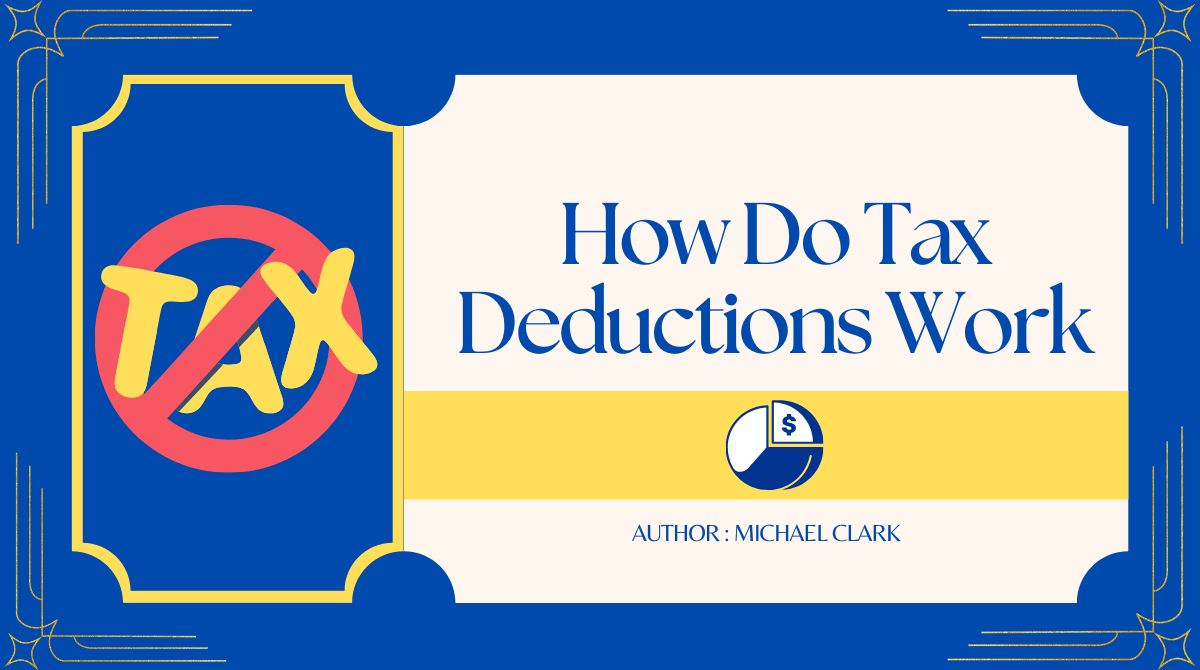
How Do Tax Deductions Work? The Complete Guideline
Tax season isn’t anyone’s favorite time of year. All those forms, numbers, and terms like deductions, credits, and adjusted gross income can make your head spin. But here’s the thing: understanding just one key concept how do tax deductions work can actually save you money and make filing a little less stressful. I have explained below how tax deductions work, why they matter, and how you can make the most of them without feeling difficult.
What Are Tax Deductions?
A tax deduction is basically a reduction in your taxable income. That means the government lets you subtract certain expenses from your income, so you don’t have to pay taxes on every single dollar you earn. Let’s say you made $60,000 last year. If you qualify for $10,000 in tax deductions, the IRS won’t tax you on the full $60,000 just on $50,000. The less income that’s taxed, the less money you owe. Simple, right? No the tricky part is knowing which expenses count, and how to claim them.
Learn more about Education Credits
Why Do Tax Deductions Exist?
You might be wondering why does the government even offer deductions in the first place. It’s a fair question. The idea is to encourage certain behaviors or help people with life circumstances. For example, the government wants you to save for retirement, go to school, or donate to charity. So if you do, they give you a little break on your taxes. It’s kind of like a reward.
In other cases, deductions exist to account for necessary expenses, like business costs or medical bills, that take a chunk out of your income. The tax system recognizes that not all income is freely spendable, and deductions help reflect that.
How Do Tax Deductions Work in Practice?
Let’s go a little deeper now and talk about how this all plays out when you're actually filing your taxes.
There are two main types of deductions:
1. Standard Deduction
The standard deduction is a fixed dollar amount that most people qualify for. You don’t have to prove anything or show receipts. The IRS just gives it to you automatically unless you choose to itemize (we’ll get to that next).
For the 2024 tax year (filed in 2025), the standard deduction is:
|
Filing Status |
Standard Deduction |
|
Single |
$14,600 |
|
Married Filing Jointly |
$29,200 |
|
Head of Household |
$21,900 |
So if you're single and made $50,000 in 2024, and you take the standard deduction of $14,600, your taxable income becomes $35,400. That’s the amount the IRS will calculate your tax bill from.
2. Itemized Deductions
Itemized deductions take a bit more effort than the standard deduction, but they can be worth it if your qualified expenses are high. Instead of claiming a fixed amount, you list out individual deductible expenses things like mortgage interest, property taxes, medical expenses (if they’re significant), state and local taxes, charitable donations, casualty or theft losses, and even investment interest. These are all amounts the IRS allows you to subtract from your income, reducing the portion that's taxed.
If the total value of your itemized deductions exceeds the standard deduction for your filing status, itemizing usually results in a lower tax bill. Here’s a quick example to help you see the difference:
|
Expense Type |
Amount Paid |
|
Mortgage Interest |
$8,000 |
|
Property Taxes |
$5,000 |
|
Charitable Donations |
$2,000 |
|
Total Itemized Deductions |
$15,000 |
The standard deduction for a single filer in 2024 is $14,600. Since your total itemized deductions come to $15,000, it makes financial sense to itemize in this case you’d reduce your taxable income by a larger amount than you would with the standard deduction.
Why Knowing Your Tax Deductions Early Can Save You Big
Most people only start thinking about taxes when April is around the corner but that might be too late to take full advantage of all the deductions available to you. The truth is, the earlier in the year you understand how tax deductions work, the better your chances of using them wisely.
There are hundreds of legal deductions out there, yet millions of Americans either don’t know about them or don’t know how to use them correctly. In fact, the IRS is currently holding over $1 billion in unclaimed tax refunds. That’s money people could’ve saved if only they’d claimed their deductions in time.
Talking to a tax professional early in the year, rather than rushing during tax season, can help you plan better. Whether it’s a certified tax preparer or a tax attorney, professionals know the ins and outs of deductions and can help you document your expenses, organize receipts, and spot opportunities to legally lower your tax bill.
Remember, deductions aren’t just for the rich. Many middle- and lower-income taxpayers qualify for valuable deductions they just need to know what to look for and when to act.
Common Tax Deductions You Might Already Qualify For
This is where things get really interesting. Believe it or not, many people miss out on hundreds or even thousands of dollars in potential savings each year simply because they’re unaware of the deductions they’re already eligible for. The truth is, the IRS offers a variety of deductions for everyday expenses, especially for those who work from home, are self-employed, or are repaying loans. Let’s take a closer look at some of the most common tax deductions that many people overlook but may already qualify for.
Home Office Deduction
If you’ve been working from home whether full-time or just for a side hustle you may be able to deduct a portion of your home expenses. The key requirement is that the space you use must be exclusively and regularly used for business purposes. That means your kitchen table or a couch in the living room won’t cut it. But if you have a dedicated room or even a portion of a room used only for work, you might be able to deduct part of your rent, utilities, internet costs, and even mortgage interest.
For example, if your home office takes up 10% of your apartment and your yearly rent and utilities come to $15,000, you could deduct around $1,500. If you prefer the simplified method, the IRS allows $5 per square foot of your home office space, up to 300 square feet meaning your deduction could be as much as $1,500 using that method as well.
Mileage or Car Expenses
Driving your personal car for business-related activities? You could be sitting on a solid deduction. If you use your vehicle for work excluding your regular commute you can deduct either the standard mileage rate set by the IRS each year or actual expenses like gas, maintenance, and insurance.
For example, let’s say you drove 3,000 miles in 2024 for business purposes. With the IRS standard mileage rate set at 67 cents per mile, that adds up to a $2,010 deduction. If you kept detailed records and your actual car expenses for those miles exceed $2,010, you can deduct the higher amount instead. It’s especially useful for freelancers, delivery drivers, and consultants who are often on the road.
Job-Related Expenses
If you're self-employed, many of the expenses you incur while running your business are deductible. This includes everything from office supplies and advertising costs to software subscriptions, licensing fees, and even part of your internet bill. For example, if you spent $600 on design software, $400 on a new phone for work, $300 on office supplies, and $700 on digital marketing services, you’re looking at $2,000 in potential deductions. The IRS considers these expenses “ordinary and necessary,” and they can significantly reduce your tax bill if you’re running a small business or freelance operation.
Student Loan Interest
You can deduct up to $2,500 in interest paid on qualified student loans each year, and the best part is, you don’t even have to itemize to claim it. For example, if you’re paying about $200 a month in loan interest, that’s $2,400 a year, which puts you very close to the maximum deduction limit. And if your parents are helping you pay, and you're not being claimed as a dependent on their return, you might still qualify to deduct the interest yourself. This one’s a lifesaver for recent grads trying to manage education debt.
Medical and Dental Expenses
Healthcare costs can be overwhelming, but some of them might help reduce your tax bill. If your unreimbursed medical and dental expenses exceed 7.5% of your adjusted gross income (AGI), you may be able to deduct the amount that goes beyond that threshold.
So, for instance, if your AGI is $60,000, anything above $4,500 in qualifying medical expenses can be deducted. If you had $7,000 in medical costs that year, your eligible deduction would be $2,500. This includes everything from doctor visits and prescriptions to surgeries, therapy, dental work, and even certain travel expenses to receive care.
Charitable Contributions
If you’ve made donations to qualified charitable organizations whether in cash, goods, or even miles driven for charitable purposes you may be able to deduct them from your taxable income. Let’s say you gave $1,000 in cash donations, donated clothing and household items worth $300, and drove 150 miles volunteering throughout the year. At the IRS rate of 14 cents per mile, that adds $21 in mileage deductions, bringing your total to $1,321 in charitable deductions. Just make sure to keep your receipts or written acknowledgments for any donations, and remember that even small contributions can add up over time.
How Do Tax Deductions Work Differently Than Tax Credits?
This part confuses a lot of people and I don’t blame them.
-
Tax deductions lower your taxable income.
-
Tax credits lower your tax bill directly.
So if you’re in the 22% tax bracket, a $1,000 deduction saves you about $220. But a $1,000 credit saves you the full $1,000. That’s why credits are more powerful, but deductions still add up and can make a big difference.
How to Claim Tax Deductions
Now that you understand how do tax deductions work, the next question is howto claim tax deductions. It’s not as difficult as it sounds, especially if you take it step by step. Here’s how to make sure you claim every deduction you're entitled to:
1. Gather Your Documents
Start by collecting all the paperwork you’ll need. This includes W-2s, 1099s, mortgage interest forms, student loan interest statements, and any receipts for deductible expenses like medical bills or charitable donations. Having everything ready will make the filing process faster and smoother.
2. Choose Your Filing Method
Most people either use tax filing software (like TurboTax or H&R Block) or hire a professional tax preparer. Both options will guide you through the process, but if your taxes are complex or you're unsure about deductions, it’s worth getting help from a pro.
3. Decide Whether to Itemize or Take the Standard Deduction
Once you're in the filing process, you'll need to decide between itemizing your deductions or taking the standard deduction. The software or your tax preparer will usually show you which option saves you more money.
4. Enter Your Deductions
If you’re taking the standard deduction, it’s applied automatically. If you’re itemizing, you’ll need to enter each qualified expense like mortgage interest, state taxes, medical costs, and so on. Be sure to use accurate amounts and keep your records.
5. Double-Check Everything
Before you submit your return, take a few minutes to review everything. A small mistake like a missing number or wrong entry can delay your refund or even cause an audit. Most software has a review step built in, so don’t skip it.
Can Tax Deductions Get You a Bigger Refund?
In short yes, they can. The lower your taxable income, the less tax you owe. And if you've already paid more in taxes through paycheck withholding or estimated payments, deductions can push you into refund territory. But remember: deductions don’t automatically mean a refund. They just reduce your income on paper. Whether or not you get money back depends on your full tax situation.
What Happens If You Miss a Deduction?
It’s not the end of the world, but it could cost you. If you realize later that you forgot to claim something, you can file an amended return using Form 1040-X. You usually have up to three years to fix it and get any additional refund. So if you find an old receipt for a $1,000 donation sitting in a drawer don’t toss it. It might still be useful.
Should You Itemize or Take the Standard Deduction?
Honestly, most people take the standard deductions because it’s easier, and for many, it results in a lower tax bill anyway. But if you own a home, have high medical expenses, or donate a lot to charity, itemizing might be worth it. It all comes down to which gives you the bigger total deduction. A good rule of thumb: if your potential itemized deductions add up to more than the standard deduction, take the time to itemize. Otherwise, save yourself the stress and go standard.
Final Thoughts
You don’t need to be wealthy or run a big business to benefit from tax deductions. Everyday people qualify for them all the time you just need to know what to look for. Track your expenses, know your options, and don’t be afraid to ask for help. Book your free consultation today or drop a message our experts will reach out to you. Now that you understand how do tax deductions work, you’re in a much better position to make tax season a little less painful and maybe even a bit rewarding.
Follow SKFinancial on Facebook / Twitter / Linkedin / Youtube for updates.












